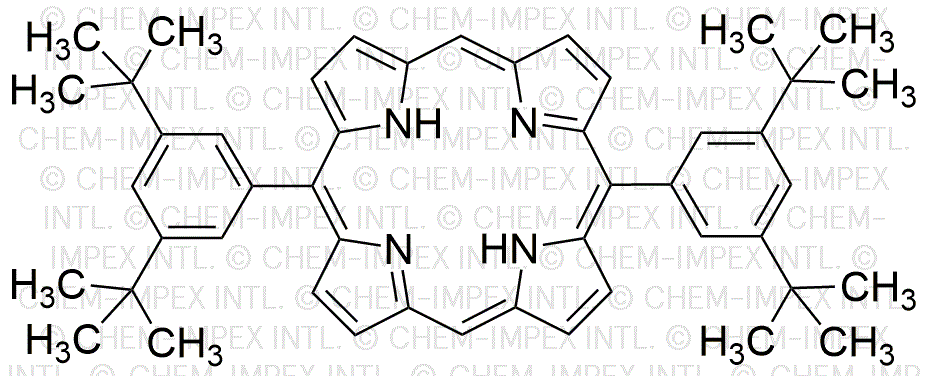5,15-(di-3,5-di-tert-Butylphenyl)porphyrin is widely utilized in research focused on:
- Solar Energy Conversion: This compound is used in the development of organic photovoltaic cells, enhancing light absorption and improving energy conversion efficiency.
- Catalysis: It serves as a catalyst in various chemical reactions, particularly in organic synthesis, due to its ability to stabilize reactive intermediates.
- Biomedical Applications: The compound is explored for use in photodynamic therapy, where it can selectively target and destroy cancer cells when activated by light.
- Sensor Technology: It is incorporated into sensors for detecting environmental pollutants, leveraging its optical properties for enhanced sensitivity and specificity.
- Materials Science: This porphyrin is utilized in the creation of advanced materials, including light-emitting devices and nanomaterials, due to its unique electronic properties.
General Information
Properties
Safety and Regulations
Applications
5,15-(di-3,5-di-tert-Butylphenyl)porphyrin is widely utilized in research focused on:
- Solar Energy Conversion: This compound is used in the development of organic photovoltaic cells, enhancing light absorption and improving energy conversion efficiency.
- Catalysis: It serves as a catalyst in various chemical reactions, particularly in organic synthesis, due to its ability to stabilize reactive intermediates.
- Biomedical Applications: The compound is explored for use in photodynamic therapy, where it can selectively target and destroy cancer cells when activated by light.
- Sensor Technology: It is incorporated into sensors for detecting environmental pollutants, leveraging its optical properties for enhanced sensitivity and specificity.
- Materials Science: This porphyrin is utilized in the creation of advanced materials, including light-emitting devices and nanomaterials, due to its unique electronic properties.
Documents
Safety Data Sheets (SDS)
The SDS provides comprehensive safety information on handling, storage, and disposal of the product.
Product Specification (PS)
The PS provides a comprehensive breakdown of the product’s properties, including chemical composition, physical state, purity, and storage requirements. It also details acceptable quality ranges and the product's intended applications.
Certificates of Analysis (COA)
Search for Certificates of Analysis (COA) by entering the products Lot Number. Lot and Batch Numbers can be found on a product’s label following the words ‘Lot’ or ‘Batch’.
*Catalog Number
*Lot Number
Certificates Of Origin (COO)
This COO confirms the country where the product was manufactured, and also details the materials and components used in it and whether it is derived from natural, synthetic, or other specific sources. This certificate may be required for customs, trade, and regulatory compliance.
*Catalog Number
*Lot Number
Safety Data Sheets (SDS)
The SDS provides comprehensive safety information on handling, storage, and disposal of the product.
DownloadProduct Specification (PS)
The PS provides a comprehensive breakdown of the product’s properties, including chemical composition, physical state, purity, and storage requirements. It also details acceptable quality ranges and the product's intended applications.
DownloadCertificates of Analysis (COA)
Search for Certificates of Analysis (COA) by entering the products Lot Number. Lot and Batch Numbers can be found on a product’s label following the words ‘Lot’ or ‘Batch’.
*Catalog Number
*Lot Number
Certificates Of Origin (COO)
This COO confirms the country where the product was manufactured, and also details the materials and components used in it and whether it is derived from natural, synthetic, or other specific sources. This certificate may be required for customs, trade, and regulatory compliance.

